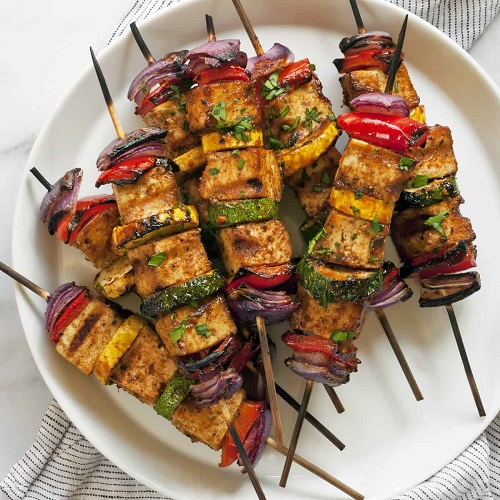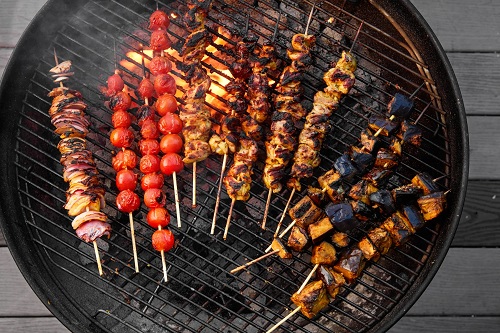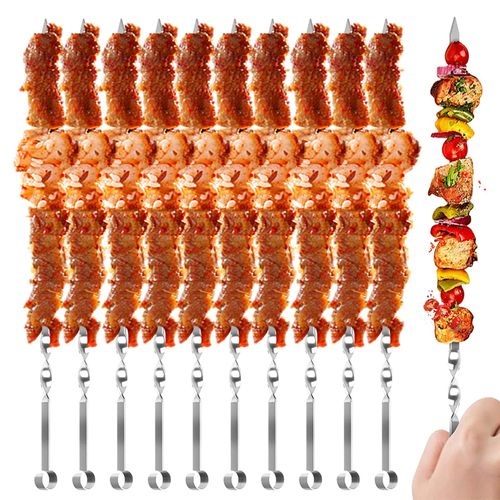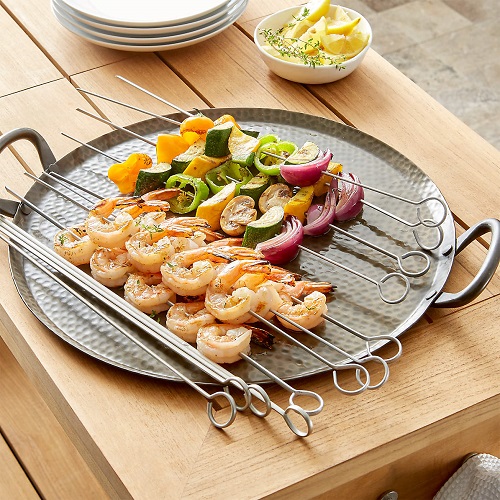Elevating Grilling with the Art of Barbecue Skewers
Unleash the potential of barbecue skewers in your grilling repertoire. From choosing the perfect skewer to crafting flavorful combinations, delve into the art and techniques that transform ordinary ingredients into delectable kebabs, creating an unforgettable outdoor culinary experience.
The Art and Techniques of Crafting Flavorful Kebabs with Barbecue Skewers

A barbecue skewer is a cooking utensil used in grilling or barbecuing to hold and cook small pieces of food. Typically made of metal or wood, barbecue skewers are long, slender rods that allow users to thread and secure various ingredients such as meat, vegetables, and seafood. These ingredients are arranged along the length of the skewer, creating a convenient and efficient way to cook and serve grilled kebabs or skewered dishes.
Barbecue skewers come in various types and materials. Metal skewers are often reusable, durable, and conduct heat efficiently, ensuring even cooking. Wooden skewers, on the other hand, are disposable and provide a rustic charm. The choice between metal and wooden skewers depends on personal preference, the type of food being cooked, and the desired presentation.
Types of Barbecue Skewers
Barbecue skewers come in various types, each catering to specific grilling needs and preferences. Here are some common types of barbecue skewers:
1. Flat Metal Skewers: These skewers have a flat, rectangular shape, offering stability to ingredients and preventing them from spinning while grilling. The flat design ensures even cooking on all sides.
2. Round Metal Skewers: Round metal skewers are cylindrical in shape and provide a classic and versatile option for grilling. They allow for easy rotation of ingredients and are often dishwasher-safe for convenient cleaning.
3. Double-Pronged Skewers: Double-pronged skewers feature two parallel tines, providing additional stability for larger or heavier ingredients. This design helps prevent items from slipping or rotating during grilling.
4. Bamboo Skewers: Bamboo skewers are a popular and economical choice. They are lightweight, disposable, and impart a natural, rustic appeal to grilled dishes. Bamboo skewers come in various lengths to accommodate different types of food.
5. Stainless Steel Skewers: Stainless steel skewers are durable, reusable, and resistant to rust. They offer efficient heat conduction, ensuring even cooking. Some stainless steel skewers may feature a flat design for improved ingredient stability.
6. Flexible Skewers: Flexible skewers are made of materials like stainless steel or heat-resistant plastic, allowing for creative and dynamic presentations. They can be bent to fit into marinating dishes and adjust to various grill shapes.
7. Wide-Blade Skewers: Wide-blade skewers have a broader surface area, providing more support for delicate items like fish fillets or vegetables. This design prevents items from tearing or breaking during grilling.
8. Ring-Top Skewers: Skewers with a ring at the top make turning and handling multiple skewers more manageable. The ring provides a convenient grip for flipping the skewers on the grill.
9. Twisted Skewers: Twisted skewers add a decorative touch to grilled dishes. The twisted design not only enhances the visual appeal but also helps ingredients stay in place during cooking.
FAQ
What kind of meat do you use for BBQ skewers?
Barbecue skewers provide a versatile canvas for grilling, accommodating a wide variety of meats, poultry, seafood, and even vegetables. Here are some popular meats commonly used for BBQ skewers:
1. Chicken: Chicken is a classic choice for skewers. Whether using boneless, skinless chicken breasts or thighs, the lean meat pairs well with various marinades and grills to perfection.
2. Beef: Beef skewers offer a hearty and flavorful option. Cuts like sirloin, flank steak, or even tenderloin can be cubed and threaded onto skewers for a delicious grilling experience.
3. Pork: Pork skewers provide a juicy and tender option. Pork loin or pork tenderloin, cut into cubes or strips, can be marinated for added flavor before hitting the grill.
4. Lamb: Lamb skewers offer a unique and robust flavor. Lamb cubes, especially from cuts like leg or shoulder, can be marinated with herbs and spices for a delicious Mediterranean-inspired dish.
5. Shrimp: Shrimp skewers are a popular seafood option. Large shrimp or prawns can be threaded onto skewers and grilled quickly for a delightful taste of the sea.
6. Salmon: Salmon skewers provide a healthy and flavorful choice. Salmon fillets, cut into chunks, can be marinated or seasoned before grilling for a delicious and nutritious meal.
7. Veal: Veal, with its delicate flavor, can be used for skewers. Similar to beef, veal cubes or strips can be threaded onto skewers for a tender and succulent result.
8. Turkey: Turkey skewers offer a lean alternative. Turkey breast or thigh meat, cut into bite-sized pieces, can be marinated or seasoned for a lighter grilling option.
9. Sausages: Sausages, whether pork, chicken, or a blend of meats, can be sliced and threaded onto skewers. This adds a flavorful twist to traditional sausage grilling.
What can I use instead of skewers sticks?
If you find yourself without skewer sticks for grilling, there are several creative alternatives you can use to achieve a similar effect. Here are some alternatives to traditional skewer sticks:
1. Rosemary Stems: Fresh rosemary stems can add a delightful aroma and flavor to your grilled dishes. Use them as skewers by removing the leaves from a portion of the stem, leaving a "stick" to thread your ingredients.
2. Lemongrass Stalks: Lemongrass stalks can serve as aromatic skewers. Peel away the outer layers, exposing the tender inner part, and use them to thread your meat or vegetable pieces.
3. Cinnamon Sticks: Large cinnamon sticks can be used for sweet or savory skewers. They add a hint of warm spice to your grilled dishes, especially when used with fruits or desserts.
4. Bamboo Chopsticks: Bamboo chopsticks, readily available in many kitchens, can be used as makeshift skewers. Simply thread your ingredients onto the chopsticks for a quick and easy alternative.
5. Metal Kabob Skewers: If you don't have traditional wooden skewers, metal kabob skewers or even metal coat hangers can be cut, shaped, and used for grilling. Ensure they are food-safe and won't impart any undesirable flavors.
6. Sugar Cane Stalks: In some regions, sugar cane stalks are used as skewers. They add a touch of sweetness to your grilled items and can be discarded after use.
7. Citrus Rinds: Citrus peels, like orange or lemon rinds, can be used as a natural skewer alternative. They add a subtle citrus flavor to your grilled dishes.
8. Wooden Rose Stems: Thin, straight wooden rose stems can be repurposed as skewers. Ensure they are clean and untreated before use.
9. Bay Leaves Stems: Fresh or dried bay leaves stems can be used as skewers, especially if you are grilling with flavors that complement the aromatic notes of bay leaves.
What is food on a skewer called?
Food that is cooked on a skewer is commonly referred to as "kebabs" or "skewers." The term "kebab" is of Persian origin and broadly refers to a variety of dishes consisting of skewered and grilled or roasted meat, seafood, or vegetables. The specific name might vary depending on the region and ingredients used. For example:
- Shish Kebab: Typically consists of skewered and grilled cubes of meat, often interspersed with vegetables.
- Chicken Skewers: Skewered and grilled or barbecued chicken pieces.
- Vegetable Kebabs: Skewers featuring a variety of grilled vegetables, sometimes combined with cheese or tofu for a vegetarian option.
- Shrimp Skewers: Skewered and grilled shrimp or prawns.
The use of skewers not only simplifies the grilling process but also allows for creative combinations of flavors and textures. Kebabs or skewers are popular in many cuisines around the world and can be found in various forms, each offering a unique and delicious culinary experience.
What is the difference between skewer and kebab?
The terms "skewer" and "kebab" are related but refer to different aspects of the culinary experience involving skewered and grilled or roasted food.
Skewer:
- A "skewer" is a tool, typically a long and narrow rod made of metal, wood, or another suitable material, used to thread and hold pieces of food for cooking. Skewers are a means of facilitating the grilling or roasting of various ingredients, and they come in different materials and designs.
Kebab:
- "Kebab," on the other hand, refers to the dish itself. It is a culinary preparation where small pieces of food, such as meat, seafood, vegetables, or a combination of these, are threaded onto skewers and then grilled or roasted. Kebabs can take various forms, such as shish kebabs (cubes of meat), chicken kebabs, vegetable kebabs, or even fruit kebabs.
A barbecue skewer is a versatile tool used in grilling to thread and cook small pieces of food. Available in various types, such as flat metal, round metal, double-pronged, and bamboo, these skewers accommodate meats, poultry, seafood, and vegetables. The choice between materials like metal and wood depends on preferences and grilling needs. Crafting flavorful combinations, marinating techniques, and mastering skewering and grilling techniques elevate the barbecue skewer into a culinary art form, transforming ordinary ingredients into delicious kebabs. Whether using traditional skewers or creative alternatives like rosemary stems or cinnamon sticks, the barbecue skewer enhances the outdoor cooking experience, providing a canvas for diverse and flavorful grilled creations.







